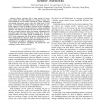28 search results - page 5 / 6 » Smart sleep: Sleep more to reduce delay in duty-cycled wirel... |
VTC
2008
IEEE
14 years 2 months ago
2008
IEEE
— Sensor networks with a large amount of sensor nodes usually have high redundancy in sensing coverage. The network lifetime can be further extended by proper scheduling and putt...
IPSN
2009
Springer
14 years 2 months ago
2009
Springer
Resilience to electromagnetic jamming and its avoidance are difficult problems. It is often both hard to distinguish malicious jamming from congestion in the broadcast regime and ...
MASS
2010
13 years 5 months ago
2010
Wireless sensor networks typically conserve energy by following a periodic wakeup-sleep schedule: nodes minimize idle time and spend most of their time in a low power sleep state. ...
TMC
2010
13 years 6 months ago
2010
—Many recent advances in MAC protocols for wireless sensor networks have been proposed to reduce idle listening, an energy wasteful state of the radio. Low-Power-Listening (LPL) ...
MOBIHOC
2002
ACM
14 years 7 months ago
2002
ACM
In wireless sensor networks, energy efficiency is crucial to achieve satisfactory network lifetime. In order to reduce the energy consumption of a node significantly, its radio ne...

